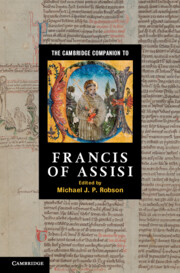Book contents
- Frontmatter
- Introduction
- PART I Francis of Assisi
- 1 Francis and the Franciscan movement (1181/2–1226)
- 2 The writings of Francis
- 3 The Rule and life of the Friars Minor
- 4 Francis and his hagiographical tradition
- 5 Voluntary simplicity: the attitude of Francis towards learning in the early biographies
- 6 Francis and the historiographical tradition in the order
- 7 Francis and Clare and the emergence of the Second Order
- 8 Francis and the encounter with the sultan (1219)
- 9 Francis and creation
- PART II The heritage of Francis of Assisi
- Index
3 - The Rule and life of the Friars Minor
from PART I - Francis of Assisi
Published online by Cambridge University Press: 28 November 2011
- Frontmatter
- Introduction
- PART I Francis of Assisi
- 1 Francis and the Franciscan movement (1181/2–1226)
- 2 The writings of Francis
- 3 The Rule and life of the Friars Minor
- 4 Francis and his hagiographical tradition
- 5 Voluntary simplicity: the attitude of Francis towards learning in the early biographies
- 6 Francis and the historiographical tradition in the order
- 7 Francis and Clare and the emergence of the Second Order
- 8 Francis and the encounter with the sultan (1219)
- 9 Francis and creation
- PART II The heritage of Francis of Assisi
- Index
Summary
The Rule and life of the Friars Minor is this: to observe the Holy Gospel of Our Lord Jesus Christ by living in obedience, without anything of one’s own, and in chastity.
RB, IThese opening lines of their Rule have guided the followers of Francis of Assisi for some 800 years. To ‘observe’ the Gospel can mean both looking at it carefully, as in ‘observing’ the stars, and carrying out what it asks, as in ‘observing’ a law or a principle. The Franciscan Rule thus requires those who profess it to pattern their lives according to the Gospel of Christ, putting its teachings into practice as members of a religious order of the Catholic Church.
The earliest draft of this Rule followed by Francis of Assisi and his brothers received its first approval in 1209. Since that time it has inspired many to become saints, just as it has spawned bitter controversies over its application in changing circumstances of Church and society. Bearing in its train this complex heritage, it continues to guide the lives of a multitude of the followers of Francis to this day. A thorough history and analysis of the Franciscan Rule and its influence through the centuries would require a long study indeed, and one that is highly desirable. Our purposes here are more modest, and of an introductory nature: to examine critical moments in the development of that Rule and its interpretation, from ‘a few words written down simply’ in 1209, through its several redactions, its formal approval in 1223, and its early interpretation by the brothers themselves and the papacy in the years immediately after the death of Francis.
- Type
- Chapter
- Information
- The Cambridge Companion to Francis of Assisi , pp. 50 - 67Publisher: Cambridge University PressPrint publication year: 2011
- 3
- Cited by



